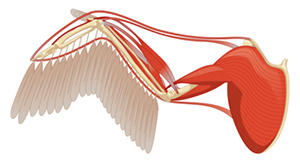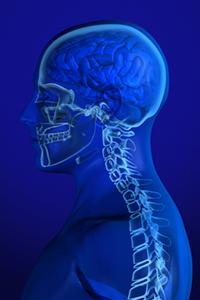Because so many animals have an endoskeleton, you might guess that having an endoskeleton helps vertebrate animals survive--and you would be right! Let's see how by taking a closer look at how the skeleton provides an organism with support, movement, and protection. Click each tab below to compare these three important functions of the skeletal system.
Shape and Support
Movement
Protection
Review
 The skeleton of this swordfish gives the animal a distinctive shape. |
First, the skeletal system functions to provide shape and support. Your height and build are determined by your skeleton. Your spine (vertebral column) gives you the ability to stand upright. In other animals, the skeleton supports the body's shape, whether the animal is meant to live on land or in water.
 The bones in this bird's wing provide a framework for muscle attachment. |
 The skeleton provides protection for important internal organs like the brain and spinal cord. |
You've learned about major functions of a vertebrate's skeletal system--but they are not the only functions of these organisms. Test your knowledge of what you have learned so far by completing the activity below.
Which is NOT a function of an animal's skeletal system?
- creating the animal's shape
- protecting the animal's internal organs
- sensing the animal's environment
- providing a framework for the animal's muscles to attach
The skeletal system is important in creating an animal's structure.
The skeletal system is important in creating an animal's structure.
The skeletal system is important in creating an animal's structure.
The skeletal system is important in creating an animal's structure.
Which is a characteristic of a vertebrate's skeletal system?
- paired limbs, wings, or fins
- skeleton on the outside of the body
- internal organs that provide protection
- a brain connected to a spinal cord
Vertebrates have appendages that are the same on each side of the body.
Vertebrates have appendages that are the same on each side of the body.
Vertebrates have appendages that are the same on each side of the body.
Vertebrates have appendages that are the same on each side of the body.
Summary
 Questions answered correctly:
Questions answered correctly:
 Questions answered incorrectly:
Questions answered incorrectly:
